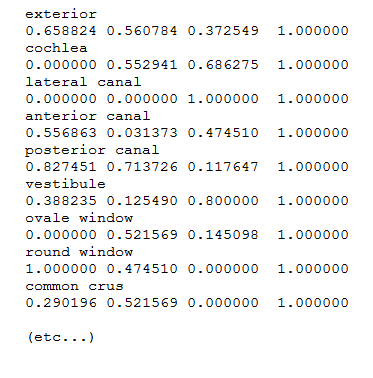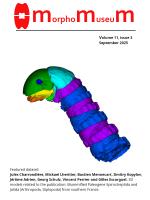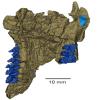Original contributions
To submit an original contribution, we ask you to provide us with:
- A cover letter
- An original article manuscript file
- A 3D data distribution statement
- A single merged pdf file, containing your manuscript + all your figures and tables.
- At least one specimen with associated 3D surface data expressed in mm. enclosed in a .zip file containing one or more surface (.PLY or .VTP/.VTK) files. Blender projects (.BLEND) are also accepted.
Original contributions: submission categories
Four main categories of original contributed articles are published in M3:
- Anatomy atlases (up to 10 printed pages*, up to 50 specimens)
- Fossil reconstructions (up to 10 printed pages*, up to 50 specimens)
- Type specimens (up to 10 printed pages*, up to 50 specimens).
- Miscellaneous (up to 10 printed pages*, up to 50 specimens)
This category is primarily designed to publish osteological anatomical
models of entire extant or fossil organisms. Publication of anatomical models displaying soft tissues
is also mostly welcome. We recommend to properly label and tag the 3D surfaces using surface editing
software such as
MorphoDig or
MeshLab
Virtual restorations of damaged fossil organisms are published in this section. Emphasis should be put on the reconstruction procedure.
Priority is set to osteological models extracted from CT-Data.
Models showing segmented anatomical structures (such as teeth, bone, cavities ...) are favored.
This category is designed to publish models which do not fit in one of the preceding
categories, but nevertheless present enough significant scientific interest.
*One page is around 7400 characters long including spaces.
.
Original contributions: guide for Authors
Please prepare the following documents before clicking on 'submit an article' button:
- Cover letter (.doc, .docx, .odt, .pdf or .txt)*,
- text file of your Original article manuscript (.doc, .docx, .odt, or .txt) starting with a title page section, and containing also figure and table captions after the reference list *,
- A fully completed and signed 3D distribution statement (.doc, .docx, .odt or .pdf)**,
- A single merged pdf file (.pdf)*, containing:
- your manuscript without the title page section (in order to keep your identity concealed from the reviewers)
- all your figures and tables.
This is the single file that will be sent to the reviewers, so it should not contain information relative to your identity. Please also DO NOT include your cover letter, neither the 3D distribution statement inside this .PDF file. Also, for the sake of clarity, please put the figure and table captions along with the corresponding figures and tables in this document. - As an option, you may fill and attach the Specimen list table.
- Figure files (.jpg, .tif, .eps, .pdf or .png)
- Tables files (.xls, .xlsx, .ods, .doc, .docx or .odt)
- if applicable, you may also include additional documents with Supplementary Online Material. Supplementary Online Material files should be compressed into one single .zip file.
- *: required for submissions
- **: required for submissions + based on the downloadable following model provided here
3D surface data:
Keep in mind that M3 primarily publishes "enriched" (= segmented, labelled, oriented, tagged or virtual restorations of damaged specimens) 3D surface models of vertebrate specimens.
- 3D data related to a given specimen must be compressed into one single .zip file.
- 3D surfaces should be expressed in millimeters (mm).
- 3D data format must be openable with freeware such as MeshLab, ImageJ, MorphoDig or other free software.
- Each .zip file should contain at least one surface file. ALL surfaces should be expressed in millimeters (mm). Please use .PLY or .VTP/.VTK formats for 3D surfaces enclosed in the .zip file (please convert .STL files as .PLY files using a freeware such as MeshLab). Point clouds are not considered as surfaces. Blender projects (.BLEND) are also accepted.
- Each .zip file should not contain any subfolder.
- Name the files enclosed inside the .zip file in a consistent and understandable manner: for instance, prefix all file names relative to one specimen with the inventory number of that specimen.
- Only include once the same piece of information inside the .zip file: for instance, avoid including the same 3D surface in different formats.
- If you have used MorphoDig to process your 3D surface(s), we encourage you to enclose as well position and orientation files (.pos and .ori ), .tag and .flg files (if applicable, see below) and project files (.ntw).
- Whether or not you have used MorphoDig to process your 3D surface(s), we ask you to provide your 3D models in a biologically relevant position and orientation. You can easily achieve this easily using MorphoDig. Non positioned/oriented 3D models might be rejected for publication.
- MorphoMuseuM displays color legends. If your surface models contain several distinct objects rendered with different colors, or if you have colored your 3D surface files,
we encourage you to enclose a .tag file inside your .zip file. You can produce a .tag file with MorphoDig or create it manually.

Tag file example
Tag files (.tag) are text files containing n pairs of lines, each pair being constructed following way:
line 2*n -1: name of the colored structure/object
line 2*n: corresponding color (red, green, blue) and transparency
- MorphoMuseuM displays flags, which are "clickable" structures of interest. If your plan to use this feature, we encourage you to enclose one or several .flg files inside your .zip file. You can produce .flg files with MorphoDig or create them manually.

Flag file example
Flag files (.flg) are text files containing n pairs of lines, each pair being constructed following way:
line 2*n -1: name of the structure of interest
line 2*n: coordinates of the structure of interest (x, y, z), flag orientation (nx, ny, nz), flag length (in mm) and flag color (r, g, b).
If you have constructed manually your .flg file(s) and are not able to set flag orientation and length, you can set nx, ny, and nz to 0.0, and flag length to 1.0.
CT/MRI data:
M3 optionally publishes CT scan / MRI representations of vertebrate specimens. Such data must meet the following requirements:
- CT or MRI data related to a given specimen must be compressed into one single .zip file, weighing up to 126 Mo. If your original CT/MRI dataset weighs more than 126 Mo, you may read our image stack optimization page. If you still do not manage to create a file weighing less than 126 Mo, you may consider to create a Dryad dataset instead, and to inform us that it should be linked to your submission.
- We recommend to use .mhd, .mha or .raw format for CT/MRI Data. However, image stacks (.bmp, .tif, .dcm) are also accepted.
- Only include once the same piece of information inside the .zip file: for instance, avoid to include the same CT/MRI data in different formats or orientations.
File size limitation for CT/MRI files: 126 Mo/file
You may think that 126 Mo is ridiculously small for a zipped CT/MRI dataset, but then again, we encourage you to read our image stack optimization page.
Original contributions: manuscript preparation
General recommendations:Manuscript authors should aim
to communicate ideas and information clearly and concisely, in language suitable for
the moderate specialist. Note: all text including tables, figure captions and literature cited
should be double-spaced, with line and page numbers.
Papers should conform to the following general layout:
Title page Section
To ensure double-blind peer review, the identity of the authors should remain
concealed from the reviewers. Therefore, authors should only provide information
about their identity in the title page section, which should remain separated from the
rest of the manuscript. When constructing your merged .PDF document, please do not forget to remove the title page section.
The title page section must contain the following elements:
- Title (it should be concise but informative, and where appropriate should include mention of family or higher taxon. Names of new taxa should not be given in title);
- Author's name (followed by a lower-case superscript letter immediately after the author's name and in front of the appropriate address);
- Authors' affiliation addresses (where the actual work was done) below the author's names (Institution's name, Department, city, state, ZIP code, and country);
- Corresponding author: Name, address, phone number, fax number, and e-mail address of the person who will handle correspondence at all stages of refereeing and publication, also post-publication. Only the email of the corresponding author is required.
- Abbreviated title (running headline) not to exceed 48 characters and spaces;
Abstract
This must be on a separate page. It should be about 100-250 words long and should summarize the paper in a form that is intelligible in conjunction with the title. It should not include references.
For higher-rank taxonomic units use Latin names.
Keywords: The abstract should be followed by three to five keywords additional to those
in the title identifying the subject matter for retrieval systems. Keywords should
not exceed 85 characters and spaces.
Body of the manuscript
The manuscript has to be organized as follows:
1 - Introduction
2 - Methods;
3 - Results / Description (optional)
4 - Discussion (which can remain short)
5 - Conclusion (optional)
6 - Acknowledgements
7 - References
Introduction
All original contributions published in M3 begin with a regular introduction, in which the interest of the associated sample of 3D models is presented. This introduction should may also refer to a table including a few characteristics of the device(s)
out of which the 3D surface models were produced and information related to the specimen(s).
Methods
You manuscript should contain a description of the procedure(s) used to produce the 3D surface models associated to your publication (e.g. manual or automatic segmentation, 3D retro-deformation protocol, surface tagging etc...). Please also mention the software you have used.
Subject matter
The paper should be divided into sections under short headings. Except in systematic hierarchies, the hierarchy of headings should not exceed three. An example of systematic hierarchy can be downloaded here.
- All letters for primary headings are in caps (e.g., INTRODUCTION, DESCRIPTION).
- Only the first letter of the secondary heading and proper nouns are in caps (e.g., Inner ear morphology.).
- Only the first letter of tertiary headings is capitalized (e.g., Semicircular canals. ).
- All headings are boldfaced. Primary and secondary headings are centered. Tertiary headings are italicized, end in a period, and are the beginning of the first line of the paragraph.
The Zoological Codes must be strictly followed. Names of genera and species should
be printed in italic. Cite the author of species on first mention.
Use SI units, and the appropriate symbols (mm, not millimeter; µm, not micron.,
s, not sec; Myr for million years). Avoid elaborate tables of original or derived
data, long lists of species, etc.; if such data are absolutely essential,
consider including them as appendices or as online-only supplementary material.
Avoid footnotes, and keep cross references by page to an absolute minimum.
In accordance with the recommendations of the International Codes of Zoological
Nomenclature (ICZN), all illustrated and described specimens should be deposited in
an appropriate public institution. Collection numbers must be quoted, preceded
by an institutional abbreviation.
References
We recommend the use of a tool such as Endnote
or Mendeley for reference management and formatting. EndNote reference style for M3
can be downloaded here.
Mendeley reference style for M3
can be downloaded here.
In the text, give references in the following forms: "Sudre et al. (1989)", "Sudre (1974) said", "Sudre (1974: 28)"
where it is desired to refer to a specific page, and "(Sudre, 1983)" where giving reference
simply as authority for a statement. Note that names of joint authors are connected by '&'
in the text. The list of references must include all publications cited in the text and only these.
Prior to submission, make certain that all references in the text agree with those in the
references section, and that spelling is consistent throughout. In the list of references,
titles of periodicals must be given in full, not abbreviated. For books, give the title, place of
publication, name of publisher (if after 1930), and indication of edition if not the first.
In papers with half-tones, plate or figure citations are required only if they fall outside the
pagination of the reference cited.
References should conform as exactly as possible to one of these four styles, according
to the type of publication cited. When applicable, please include the DOI link associated to a given publication.
Agrasar E. L., 2004. Crocodilian remains from the
Upper Eocene of Dor-El-Talha, Libya. Annales de Paléontologie 90, 209-222. https://doi.org/10.1016/j.annpal.2004.05.001
McKenna M. C., Bell S. K., 1997. Classification of Mammals above the species level.
Columbia University Press, New York.
Shoshani J., West R. M., Court N., Savage R. J. G., Harris J. M., 1996. The earliest proboscideans: general plan, taxonomy and palaeoecology.
In: Shoshani J., Tassy P. (Eds.), The Proboscidea: Evolution and Palaeoecology of Elephants and
Relatives. Oxford Unioversity Press, Oxford, pp. 57-75.
Seiffert E. R., 2003. A phylogenetic analysis of living and extinct afrotherian placentals.
PhD, Duke University.
Other citations such as papers 'in press' [i.e. formally accepted
for publication] may appear on the list but not papers 'submitted' or 'in preparation'. These should
be cited as 'unpubl. data' in the text with the names and initials of all collaborators.
A personal communication may be cited in the text but not in the reference list. Please give all
surnames and initials for unpublished data or personal communication citations given in the text.
Tables
Keep these as simple as possible, with few horizontal and, preferably,
no vertical
rules. When assembling complex tables and data matrices, bear the dimensions of the printed page
(250 x 184.6 mm) in mind; reducing type-size to accommodate a multiplicity of columns will affect
legibility. Each table should be uploaded as a separate file.
Illustrations
These normally include photographs, drawings, and diagrams in either black and white or color
(free of charge).
Use one consecutive set of Arabic numbers for all illustrations (do not separate 'Plates'
and 'Text-figures' - treat all as 'Figures'). Figures should be numbered in the order in which they
are cited in the text. Use upper case letters for subdivisions (e.g. Figure 1A-D) of figures; all
other lettering should be lower case. All lettering should be in Arial font.
Required resolution: 300 dpi at the final required image size. The labelling and any line drawings in a composite figure should be added in vector format.
Figures should not be embedded in the manuscript file; each figure should be uploaded as a separate
file.
Authors wishing to use illustrations already published must obtain written permission from
the copyright holder before submitting the manuscript.
Grouping and mounting: when
grouping photographs, aim to make the dimensions of the group (including guttering of 2 mm between
each picture) as close as possible to the page dimensions of 184.6 x 250 mm (for a two-column figure)
or 88.3 x 250 (for a one-column figure), thereby optimizing use of the available space. Remember that
grouping photographs of varied contrast can result in poor reproduction.
Original contributions: Cover letter
We recommend that the cover letter includes an explanation of why the manuscript is of
interest to M3 journal and what is novel about it.
Furthermore, you are invited to provide a list of at least 2 suggested reviewers.
In addition, you may also provide a list of non-suggested reviewers.









